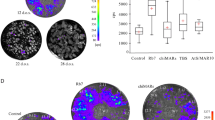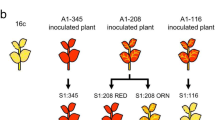Abstract
Previous work has shown that two unlinked, partially homologous transgene loci can interact in plant nuclei, leading to reversible methylation and inactivation of one transgene locus in the presence of the second. To study whether the chromosomal location of a transgene influences its susceptibility to trans-inactivation, we retransformed four transgenic lines, which contained the same construct (H) integrated in different chromosomal locations, with a second, partially homologous construct (K). At least 50 double transformants (DTs) were regenerated from each single transformant (ST) and screened for inactivation of markers [chloramphenicol acetyltransferase (CAT); hygromycin resistance (HYGR)] at the resident H locus. For two STs, H locus markers were inactivated in less than 1% of the DTs, suggesting that, at these integration sites, H was relatively resistant to trans-inactivation. In contrast, the other two STs appeared to be more sensitive to trans-inactivation: 4–10% of the DTs were CAT− and/or HygS. Inactivation of H locus markers could be attributed to two distinct phenomena:
-
1.
Regeneration from cells containing different epigenetic states of H, in which either both, one or none of the H alleles was active. This instability in the expression of the H locus, which was independent of K, was more pronounced in the homozygous state, and was associated with cellular mosaicism of expression and methylation.
-
2.
The presence of an unlinked K locus could weaken the HygR phenotype by transcriptional inactivation and increased methylation of the hph gene at the H locus. These results indicated that a susceptible transgene locus is inherently unstable and partially methylated, and that these characteristics are exacerbated when the locus is homozygous for the transgene and/or when an unlinked homologous transgene is present.
Similar content being viewed by others
References
Barnes WM (1990) Variable patterns of expression of luciferase in transgenic tobacco leaves. Proc Natl Acad Sci USA 87:9183–9187
Brink RA, Styles ED, Axtell JD (1968) Paramutation: directed genetic change. Science 159:161–170
Brussian JA, Karlin-Neumann GA, Huang L, Tobin EM (1993) An Arabidopsis mutant with a reduced level of cab140 RNA is a result of co-suppression. Plant Cell 5:667–677
de Carvalho F, Gheysen G, Kushnir S, Van Montagu M, Inzé D, Castresana C (1992) Suppression of β—1,3-glucanase transgene expression in homozygous plants. EMBO J 11:2595–2602
Goring DR, Thomson L, Rothstein SJ (1991) Transformation of a partial nopaline synthase gene into tobacco suppresses the expression of a resident wild-type gene. Proc Natl Acad Sci USA 88:1770–1774
Henikoff S, Dreesen TD (1989) Trans-inactivation of the Drosophila brown gene: evidence for transcriptional repression and somatic pairing dependence. Proc Natl Acad Sci USA 86:6704–6708
Hobbs SLA, Warkentin TD, DeLong CMO (1993) Transgene copy number can be positively or negatively associated with transgene expression. Plant Mol Biol 21:17–26
Horsch RB, Fry JE, Hoffman NL, Wallroth M, Eichholtz D, Rogers SG, Fraley RT (1985) A simple and general method for transferring genes into plants. Science 227:1229–1231
Ingelbrecht I, de Carvalho F (1992) Isolation of nuclei and in vitro run-off transcription. In: Inzé D, Van der Straeten D, Van Montagu M EMBO Practical Course on Plant Molecular Biology. Laboratorium voor Genetica, Gent, pp 117–132
Jorgensen R (1990) Altered gene expression in plants due to trans interactions between homologous genes. Trends Biotechnol 8:340–344
Jorgensen R (1992) Silencing of plant genes by homologous transgenes. AgBiotech News Inf 4:265N-273N
Kaeppler SM, Phillips RL (1993a) Tissue culture-induced DNA methylation variation in maize. Proc Natl Acad Sci USA 90:8773–8776
Kaeppler SM, Phillips RL (1993b) DNA methylation and tissueculture-induced variation in plants. In Vitro Cell Dev Biol 29P:125–130
Kilby NJ, Leyser HMO, Furner IJ (1992) Promoter methylation and progressive transgene inactivation in Arabidopsis. Plant Mol Biol 20:103–112
Kooter IN, Mol JNM (1993) Trans-inactivation of gene expression in plants. Curr Opinion Biotechnol 4:166–171
van der Krol AR, Mur LA, Beld M, Mol JNM, Stuitje AR (1990) Flavonoid genes in petunia: addition of a limited number of gene copies may lead to a suppression of gene expression. Plant Cell 2:291–299
Lagrimini LM, Bradford S, Rothstein S (1990) Peroxidase-induced wilting in transgenic tobacco plants. Plant Cell 2:7–18
de Lange P, de Boer G-J, Mol JNM, Kooter JM (1993) Conditional inhibition of β-glucuronidase expression by antisense gene fragments in petunia protoplasts. Plant Mol Biol 23:45–55
Matzke AJM, Matzke MA (1986) A set of novel Ti Plasmid-derived vectors for the production of transgenic plants. Plant Mol Biol 7:357–365
Matzke M, Matzke AIM (1993) Genomic imprinting in plants: parental effects and trans-inactivation phenomena. Annu Rev Plant Physiol Plant Mol Biol 44:53–76
Matzke AJM, Neuhuber F, Park Y-D, Ambros PF, Matzke, MA (1994) Homology-dependent gene silencing in transgenic plants: epistatic silencing loci contain multiple copies of methylated transgenes. Mot Gen Genet (in press)
Matzke MA, Primig M, Trnovsky J, Matzke AJM (1989) Reversible methylation and inactivation of marker genes in sequentially transformed tobacco plants. EMBO J 8:643–649
Matzke MA, Neuhuber F, Matzke AIM (1993) A variety of epistatic interactions can occur between partially homologous transgene loci brought together by sexual crossing. Mol Gen Genet 236:379–386
Meyer P, Heidmann I, Niedenhof I (1993) Differences in DNA-methylation are associated with a paramutation phenomenon in transgenic petunia. Plant J 4:89–100
Patterson G, Thorpe CJ, Chandler VL (1993) Paramutation, an allelic interaction, is associated with a stable and heritable reduction of transcription of the maize b regulatory gene. Genetics 135:881–894
Schernthaner JP, Matzke MA, Matzke AIM (1988) Endospermspecific activity of a zein gene promoter in transgenic tobacco plants. EMBO J 7:1249–1255
Silva AJ, Ward K, White R (1993) Mosaic methylation in clonal tissue. Dev Biol 156:391–398
Temple SJ, Knight TJ, Unkefer PJ, Sengupta-Gopalan C (1993) Modulation of glutamine synthetase gene expression in tobacco by the introduction of an alfalfa glutamine synthetase gene in sense and antisense orientation: molecular and biochemical analysis. Mol Gen Genet 236:315–325
Vaucheret H (1993) Identification of a general silencer for 19S and 35S promoters in a transgenic tobacco plant: 90 by of homology in the promoter sequence are sufficient for inactivation. CR Acad Sci [III] 316:1471–1483
Author information
Authors and Affiliations
Additional information
Communicated by H. Saedler
Rights and permissions
About this article
Cite this article
Neuhuber, F., Park, Y.D., Matzke, A.J.M. et al. Susceptibility of transgene loci to homology-dependent gene silencing. Molec. Gen. Genet. 244, 230–241 (1994). https://doi.org/10.1007/BF00285450
Received:
Accepted:
Issue Date:
DOI: https://doi.org/10.1007/BF00285450




